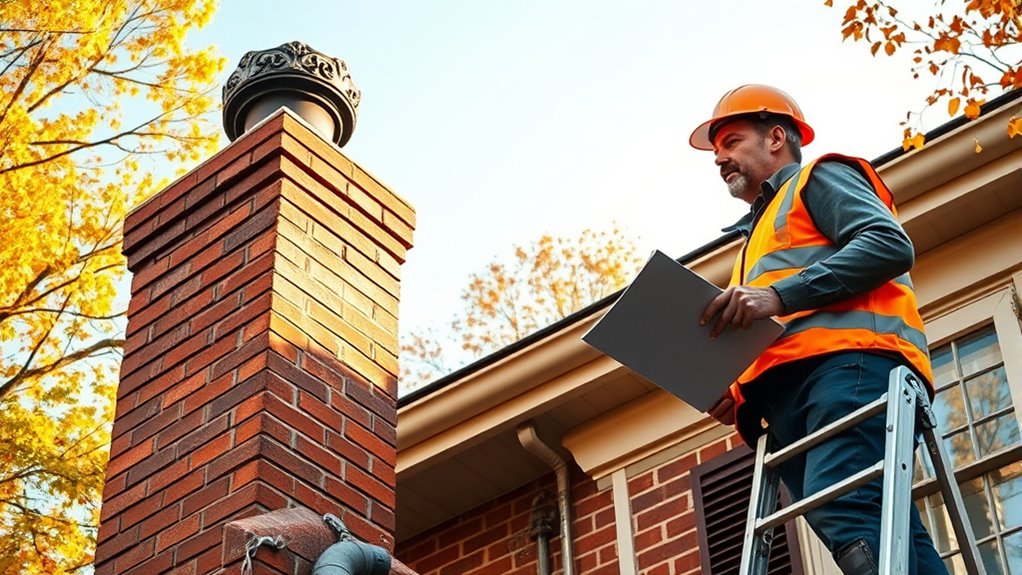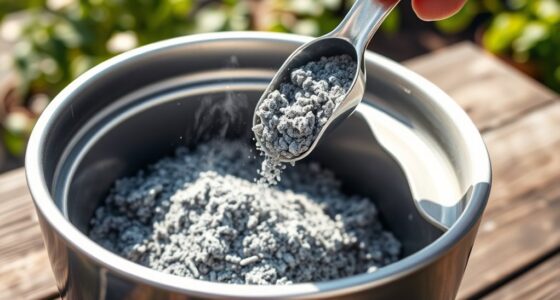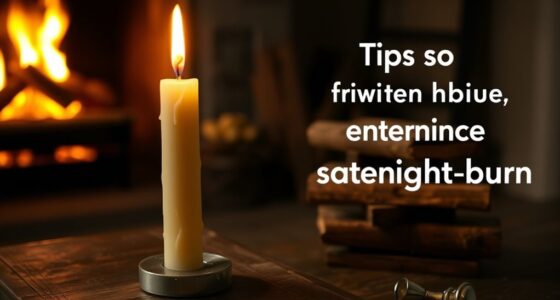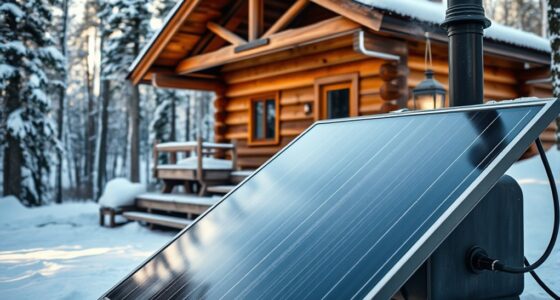To keep your fireplace safe, perform a seasonal chimney inspection by checking for loose bricks, cracked mortar, and damage to the exterior structure. Clear debris and nests from the cap and flue, and verify the cap is intact to prevent blockages. Inside, look for creosote buildup, rust, or damaged components, and test your smoke and carbon monoxide detectors. Address any issues promptly, and discover detailed tips as you continue exploring this essential safety checklist.
Key Takeaways
- Inspect exterior for loose bricks, cracked mortar, and damage; ensure chimney cap is intact and clear of debris or nests.
- Check interior for creosote buildup, soot, rust, or corrosion; verify damper functions smoothly.
- Confirm chimney cap is properly installed, undamaged, and prevents blockages from debris or animals.
- Examine hearth and surrounding areas for cracks, damage, and obstructions; maintain safe clearance.
- Test smoke and carbon monoxide detectors; schedule professional inspection for liner damage or extensive repairs.
Pre-Season Chimney Safety Inspection Checklist

Have you ever wondered if your chimney is safe and ready for the upcoming season? Ensuring your chimney’s safety is vital to protecting your home and loved ones from potential fire hazards. Before lighting that first fire of the season, it’s wise to perform a thorough inspection. This involves checking for signs of damage, blockages, or wear that could compromise fireplace safety. Taking the time to do this now can save you from costly repairs later and provide peace of mind during chilly nights.
Inspect your chimney now to ensure safety and prevent costly repairs before fireplace season begins.
Start by examining the exterior of your chimney. Look for loose bricks, cracked mortar, or signs of deterioration. These issues can allow water to seep in, causing further damage and weakening the structure. Remove any debris or nests that might have accumulated on the chimney cap or in the flue opening. A clear chimney ensures unobstructed airflow and reduces fire risks. Next, inspect the chimney cap itself—if it’s damaged or missing, animals or debris could enter, creating blockages or fire hazards. Installing or repairing a cap is a simple but essential chimney maintenance tip that helps keep your fireplace safe.
Inside, it’s important to assess the interior components. Using a flashlight, look up the chimney flue for creosote buildup or soot, which can ignite and cause dangerous chimney fires if left unchecked. If you notice excessive buildup, scheduling a professional cleaning is a smart move. Also, check the damper to ensure it opens and closes smoothly; a stuck damper can prevent proper ventilation or lead to smoke backup into your home. If you find any signs of rust, corrosion, or damage, consider replacing or repairing these parts before you start using your fireplace again.
Don’t forget to inspect the hearth and surrounding areas for cracks or damage. These can compromise fireplace safety and should be repaired promptly. Additionally, ensure your smoke and carbon monoxide detectors are in working order—test them and replace batteries if needed. A well-maintained chimney also means keeping an eye on the chimney liner. Cracks or deterioration here can allow dangerous gases to escape into your home. If you notice any issues, contact a professional chimney sweep for a detailed inspection and repair.
Performing this seasonal chimney inspection isn’t just about preventing fires; it’s about securing your home and family’s safety. Following these chimney maintenance tips will help you identify potential hazards early, making your fireplace both safer and more efficient. When you take these simple steps now, you’ll enjoy cozy, worry-free fires all season long.
Frequently Asked Questions
How Often Should I Schedule Chimney Inspections?
You should schedule chimney inspections at least once a year to guarantee proper chimney maintenance and safety precautions. Regular inspections help identify potential issues like creosote buildup, cracks, or blockages that could cause fires or carbon monoxide leaks. If you use your chimney frequently or notice problems like smoke backup or strange odors, consider inspecting it more often. Staying proactive keeps your home safe and prevents costly repairs.
What Signs Indicate Chimney Damage or Blockages?
You should watch for signs like creosote buildup, which can cause chimney fires, or animal intrusions that block airflow and create hazards. Look for smoke backing up into your home, unpleasant odors, or unusual noises. Cracks, rust, or soot buildup are also red flags. If you notice any of these signs, it’s time to get a professional inspection to guarantee your chimney’s safety and proper functioning.
Are DIY Chimney Inspections Effective or Recommended?
DIY chimney inspections can help you spot obvious issues, but they’re not always reliable. You should prioritize DIY safety and use proper inspection tools like a flashlight, mirror, and gloves. However, for a thorough assessment and to guarantee safety, it’s best to hire professionals. They have the experience, specialized tools, and knowledge to identify hidden problems that DIY inspections might miss, reducing risks of fire or damage.
What Are the Costs Associated With Professional Chimney Inspections?
When you consider professional chimney inspections, you’ll find that inspection costs can vary based on the service pricing and the complexity of the inspection. Typically, expect to pay between $100 and $300, depending on factors like the chimney’s condition and location. It’s a worthwhile investment to guarantee safety, prevent costly repairs, and maintain efficient operation. Always compare service pricing and ask about any additional fees before booking your inspection.
How Can I Prevent Chimney Issues During Off-Season Months?
To prevent chimney issues during off-season months, you should regularly perform chimney cap maintenance to keep debris out and guarantee proper airflow. Additionally, focus on creosote buildup prevention by scheduling occasional inspections and cleaning, especially if you’ve used your chimney recently. Keep an eye out for animal nests or blockages, and consider installing a chimney cap if you don’t already have one to protect your chimney year-round.
Conclusion
So, after all that effort checking your chimney, you might think you’re fully prepared for winter. But remember, even the best inspections can’t guarantee safety if you ignore warning signs or neglect regular maintenance. Ironically, the smallest overlooked detail could lead to the biggest trouble. Stay vigilant, stay safe, and keep up with your inspections—because a cozy fire isn’t worth risking your home or your family’s safety. Sometimes, the simplest precautions make the biggest difference.









